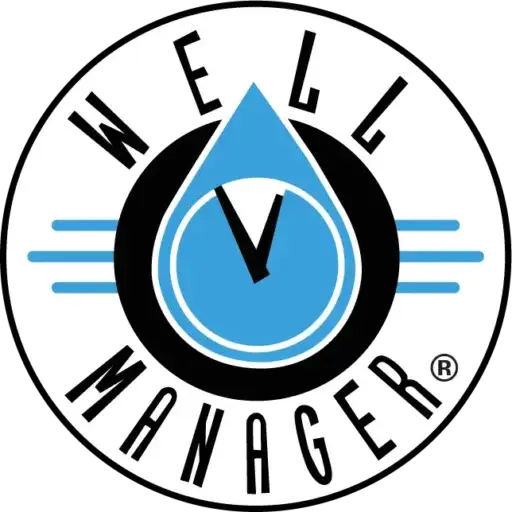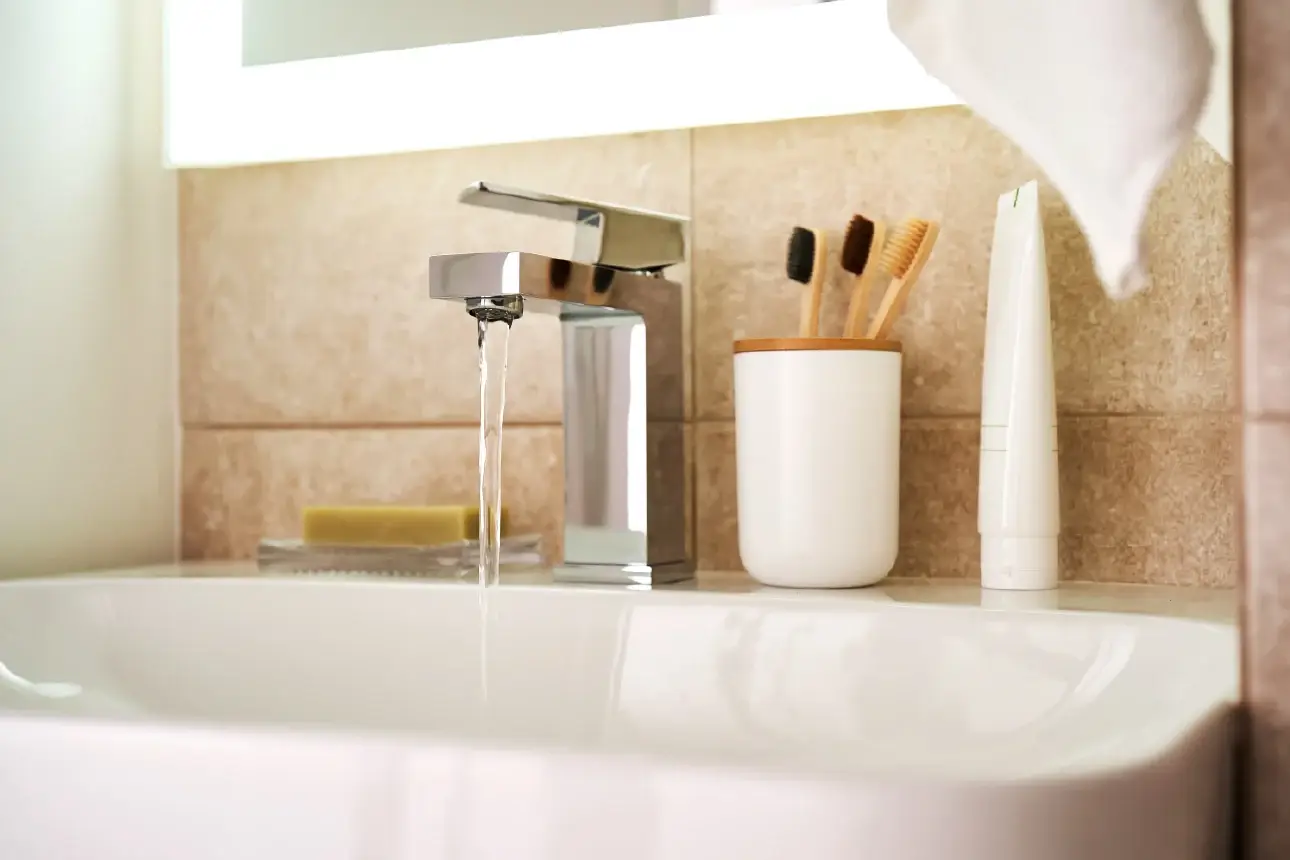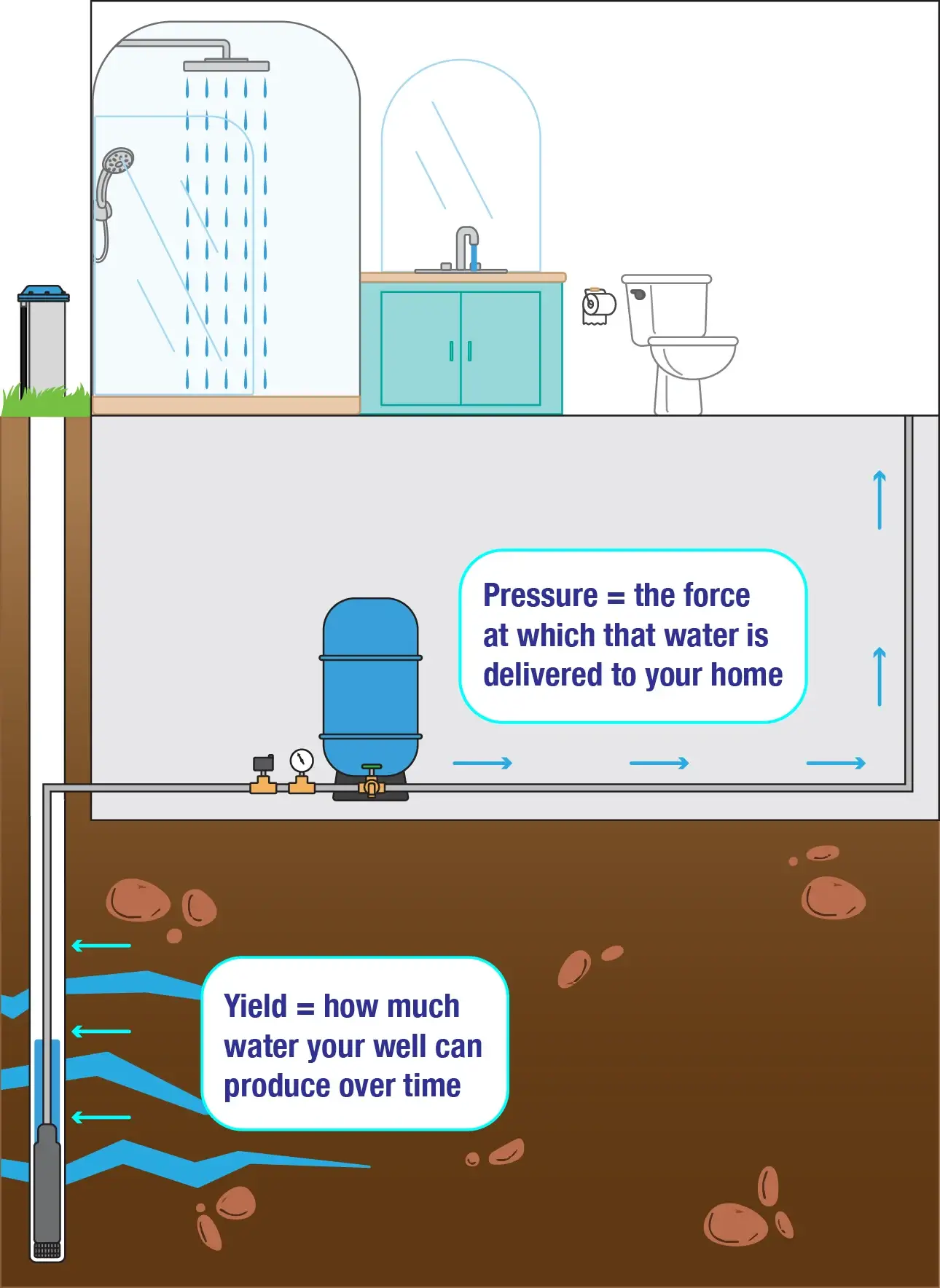A shower that sputters. A washing machine that fills slowly. Faucets that hiss before they flow. For many homeowners, these are signs of low water pressure, but what’s really changing may be happening underground.
At Well Manager, we see this pattern constantly. A water system that once ran fine begins to falter, and the fix is not always a new pump or a bigger tank. Real improvement starts with understanding what causes low water pressure and how to increase it safely by working with, not against, your well’s natural limits.
The Two Forces Behind Every Well System
Water pressure is the force that moves water through your home’s plumbing. It comes from your pressure tank and switch, not directly from the well. Most homes operate at 50-60 psi, which is plenty for normal use if the plumbing and tank are working correctly. Colorado State University Extension notes that even outdoor drip irrigation systems run at only 20–30 psi, so household pressure is designed to be strong.
Well yield, on the other hand, is the rate at which the well can supply water without running dry. The Alabama Cooperative Extension System explains that yield depends on geology, recharge rate, and well construction. Some wells can deliver ten gallons per minute or more. Others manage only one.
When yield drops, pressure suffers. The well can no longer keep up with demand, the tank empties, and the household experiences low water pressure even though the pump and controls are still working.
When Low Water Pressure Means Low Yield
Most “pressure problems” are actually yield problems. A pressure tank can only supply what the well provides. If the water level falls or the screen becomes clogged with minerals or bacteria, the tank refills too slowly, and pressure collapses during high demand.
Penn State Extension explains that the usable volume in a pressure tank, called drawdown, is only a fraction of the tank’s size. Once that small reserve is gone, the pump must refill it. If the well can’t replenish fast enough, no amount of tank adjustment will solve the issue.
True low pressure, by contrast, comes from surface restrictions: clogged filters, undersized pipes, or a failing pressure switch. These can often be corrected quickly. The key is identifying whether the issue is mechanical or geological before you invest in the wrong fix.
What Causes Low Yield and Poor Pressure
Yield loss begins underground. According to Alabama Extension, the type of rock or soil around your well controls how easily water can move. Coarse sand and fractured bedrock flow freely, while clay or solid rock restricts movement. Over time, iron bacteria and mineral buildup narrow the well screen and reduce inflow.
Inside the home, the signs are clear: weaker flow when multiple fixtures run, a pump that never seems to shut off, or water that starts strong and then fades. InspectAPedia notes that these patterns are often early warnings of a declining well or a system drawing water faster than the aquifer can recover.
Routine testing helps. The University of Rhode Island recommends measuring both the static and pumping water levels to see how the well performs under stress. Tracking that recovery over time tells you whether yield is stable or slipping.
How to Increase Water Pressure Safely
Many homeowners ask how to increase water pressure when their well starts lagging. The answer depends on the cause. If the problem is restricted flow, start with simple fixes, such as:
- Replace clogged sediment filters.
- Flush pipes and aerators.
- Adjust the pressure switch settings to standard 40/60 psi if safe for your system.
If the problem is low yield, increasing pressure without increasing storage only makes matters worse. The Pennsylvania State University Extension warns that a larger pressure tank or a higher switch setting will not overcome a slow-recovering well. The real solution is to add storage and a water pressure booster system that separates supply from demand.
A storage tank (or cistern) lets the well fill slowly while a booster pump delivers consistent pressure to the home. The University of Arizona’s Cooperative Extension confirms that this approach reduces pump cycling, protects the well, and provides strong, even pressure at every tap. For many homes, adding storage and a booster pump is the single best way to increase water pressure while keeping the well safe.
The Role of the Water Pressure Booster
A water pressure booster, often called a booster pump, draws from stored water and maintains a steady 50–60 psi throughout the home. Interstate Drilling & Pump explains that constant-pressure systems use variable-speed pumps to match flow, eliminating most pressure swings during operation.
However, these systems must be installed correctly. Without proper storage, a booster pump can outpace the well’s recovery and cause drawdown damage. The best setup combines three things: a gentle submersible pump in the well, a properly sized cistern, and a variable-speed booster pump that manages delivery to the house.
This arrangement provides immediate improvement in water pressure without stressing the source, turning a low-yield well into a reliable system that feels like city water.
Maintenance That Keeps Pressure Steady
Even the best equipment needs maintenance. The University of Arizona advises cleaning wells affected by mineral scale or bacterial slime to restore flow. Mechanical agitation and chlorination can help, but must be followed by thorough flushing and testing.
Inspect the pressure tank annually. Set the pre-charge about two pounds below the cut-in pressure, and replace tanks or switches that short-cycle. Test yield each year and log the results. According to Penn State Extension, a small decline in recovery time is the first signal of a larger issue.
Regular attention prevents the slow slide into low water pressure and helps you spot yield loss before the pump or well fails completely.
Design for Reality, Not Assumption
A well that produces only 1 gallon per minute can still meet a family’s needs if designed correctly. Imagine a home that uses 300 gallons in two hours. That well produces just 120 gallons during that time. A 300-gallon cistern bridges the gap, allowing the well to refill slowly throughout the day.
Penn State Extension highlights this method—adding intermediate storage and a water pressure booster—as one of the most efficient ways to manage low-yield wells. It protects the source, prevents short-cycling, and ensures consistent pressure even during peak demand.
Building Long-Term Pressure and Confidence
Every water system is a balance between what nature provides and what the household demands. Increasing water pressure without understanding that balance often means short-term comfort at the cost of long-term damage.
The best way to increase water pressure in a well system is to manage yield first, add smart storage, and then use a properly sized water pressure booster to stabilize delivery. That combination keeps pumps healthy, protects aquifers, and restores the steady comfort homeowners expect.
At Well Manager, we help families design systems that make the most of every gallon. We measure actual yield, install pressure boosters and storage where needed, and create solutions that make water as dependable as it should be: quiet, strong, and always there when you turn the tap.
Related Reading
- Low Water Pressure Well: Why They Happen and How Well Manager Solves the Problem
- Why Does Well Water Pressure Drop When You’re Away?
- Low Water Pressure After Switching to Well Water? How Suburban Homeowners Can Manage Pressure and Yield
- How to Increase Water Pressure When Standard Well Fixes Fall Short
- Is Your “Cost-Effective” Well Pressure Booster Solution Actually Saving You Money?



